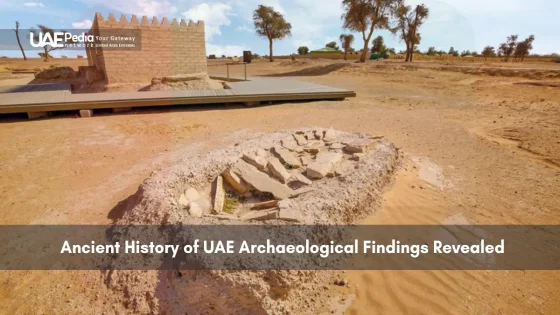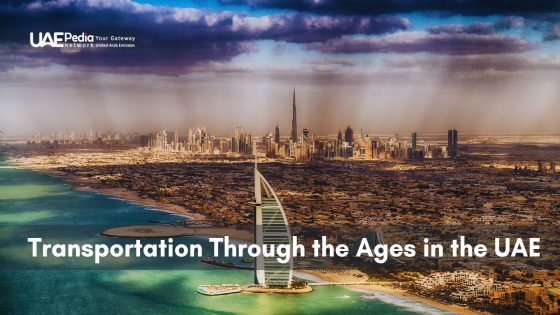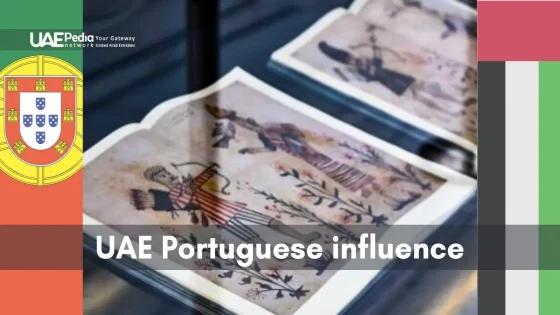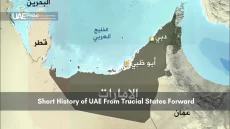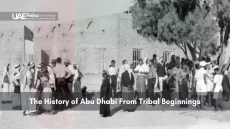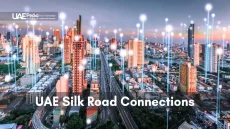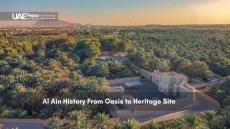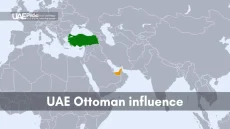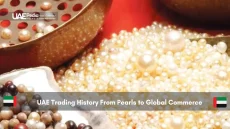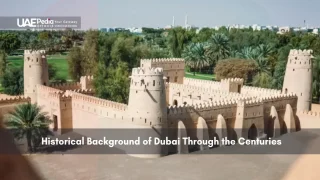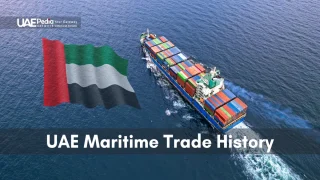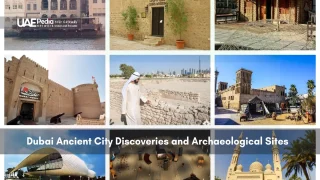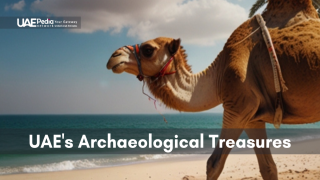What if Dubai’s glittering skyline wasn’t born from oil wealth but centuries of strategic hustle? Long before Burj Khalifa pierced the clouds, 10th-century cartographer Muhammad al-Idrisi mapped thriving settlements here – proof this land always thrived as a crossroads. Venetian trader Gasparo Balbi’s 1580 journals reveal pearl divers and fishermen trading goods where mega-malls now stand.
This desert gem’s story isn’t about sudden riches. It’s layered like saffron in karak chai: a pearling economy that lured global merchants, creek-side souqs buzzing with frankincense traders, and leaders who turned harsh sands into opportunity. Even without oil, Dubai’s DNA as a maritime hub destined it for reinvention.
We’ll walk through pivotal moments that reshaped the United Arab Emirates’ most iconic city. You’ll discover:
- How ancient trade routes set the stage for today’s economic powerhouses
- The clever adaptations that turned seasonal camps into permanent communities
- Why tradition and futurism coexist in its glass-and-limestone skyline
Pack your curiosity – we’re tracing 1,000 years of grit and vision. No time machines needed.
Introduction to Dubai’s Transformational Journey
Before the world’s tallest building, there were pearl divers shaping destiny. Picture this: golden dunes stretching endlessly, interrupted only by clusters of coral houses hugging Dubai Creek. Now fast-forward – those same sands host glass titans reflecting cloud-piercing ambition. How did a fishing village become the Arab Emirates’ beating heart of innovation?
Sandstone Roots Meet Silicon Dreams
Three seismic shifts define this city‘s rise:
- 1800s: Coastal traders bartering pearls under palm-frond shades
- 1960s: Oil discoveries funding roads, ports, and hospitals
- 2000s: Skyward sprints creating a world-class business playground
Bedouin hospitality still flavors interactions – you’ll taste it in cardamom-spiced coffee served beside digital payment terminals. Political savvy sealed the deal. The 1892 Exclusive Agreement with Britain? That treaty turned the region into a safe harbor for global merchants.
Contrasts That Captivate
| Aspect | Traditional | Modern |
|---|---|---|
| Economy | Pearling, fishing | Global trade hubs |
| Transport | Camels & dhows | Hyperloops & metro |
| Architecture | Wind towers | Twisting skyscrapers |
We’re not just touring landmarks – we’re decoding how the Arab Emirates’ most dynamic city reinvented survival. From souq haggling to NFT trading floors, every alley whispers: “Watch what’s next.” Ready to trace the blueprint?
Early Beginnings and Coastal Settlements
Imagine wandering through dunes that once cradled ancient mangrove swamps—7,000 years before skyscrapers cast shadows. Recent digs reveal our story starts much earlier than history books often claim.
Nomadic Origins and Agricultural Innovations
Around 7000 BCE, seasonal camps dotted the coast. Nomadic herders didn’t just survive the harsh climate—they thrived by engineering clever solutions. Date palm cultivation emerged by 2500 BCE, transforming the local economy. These early farmers mastered falaj irrigation systems, turning arid patches into green oases.
Archaeologists found animal bones near Jumeirah’s coast—proof of livestock trading. Goats and camels weren’t just food sources. They became living currency in a region where resources were scarce.
Archaeological Insights and Ancient Trade Routes
Excavations near Dubai Creek uncovered Mesopotamian pottery shards. How’d they get here? Coastal traders paddled goods along routes stretching to modern-day Oman and Iraq. By 3000 BCE, this area buzzed with bartered copper, pearls, and dried fish.
Scattered camps gradually clustered into permanent settlements. Families built homes from palm fronds and coral stone—materials that whispered, “We’re here to stay.” The economy thrived on three pillars: farming, herding, and maritime exchange.
Centuries before oil or pearls, these communities wove an economic web connecting distant cultures. Their resilience? That’s the real foundation beneath today’s glass towers.
The Rise of the Pearling Industry and Maritime Trade
In 1580, Venetian trader Gasparo Balbi scribbled in his journal: “The Gulf’s waters shimmer with more wealth than Venice’s canals.” He wasn’t exaggerating. For three centuries, divers risked everything to harvest nature’s hidden currency – pearls that funded empires and forged rivalries across the Arabian Peninsula.
White Gold Beneath the Waves
Pearls became the region’s first global commodity. By the 19th century, over 1,200 boats worked Dubai’s waters during summer harvests. These luminous gems:
- Funded 95% of local households by 1900
- Traded in Bombay and Paris as luxury status symbols
- Created a specialized economy with roles from divers to auctioneers
Abu Dhabi’s deeper harbors initially gave it an edge. But Dubai’s merchants adapted faster, using trade networks stretching to India and East Africa.
Harbors of Opportunity
When Japanese cultured pearls crashed markets in the 1930s, Dubai pivoted. Leaders invested pearl wealth into critical infrastructure:
| Pearling Era | Modern Trade |
|---|---|
| Wooden dhows | Jebel Ali Port |
| Coral warehouses | Free economic zones |
| Monsoon-dependent voyages | 24/7 cargo flights |
The 1902 tax waiver for foreign merchants cemented Dubai as the Gulf’s capital of commerce. While Abu Dhabi focused on territorial control, this city bet on becoming a middleman – a strategy still shaping its skyline today.
British Influence and Early Maritime Treaties
While pearl divers plunged into Gulf waters, another drama unfolded onshore—one involving ink-stained treaties that reshaped the region’s destiny. British naval officers and local leaders huddled under canvas tents, negotiating deals that would pivot this emirate from pirate haven to trade powerhouse.
Impact of the General Maritime Peace Treaty
The 1820 agreement wasn’t just paperwork—it was survival. After decades of pirate raids threatened British India’s shipping lanes, the treaty banned armed vessels along the coast. Suddenly, merchants could sail without fear of losing cargo (or heads). By 1853, a follow-up deal dubbed the “Perpetual Maritime Truce” turned the Gulf into a guarded trade corridor.
Shaping Political Relationships in the Gulf
Britain didn’t just bring rules—they brought receipts. In exchange for protection, leaders agreed to:
- Ban slave trading in their ports by 1839
- Fly the British flag on ships as a piracy deterrent
- Let Britain mediate disputes between coastal tribes
The results? Trade revenue tripled by 1890. Dubai’s creek became a magnet for Indian merchants and Iranian boat builders. While Abu Dhabi focused on territorial control, this emirate doubled down on becoming the region’s duty-free shop—a strategy oil magnates would later turbocharge.
The Emergence of the Al Maktoum Dynasty
Picture a desert council where leaders sip Arabic coffee while sketching plans for artificial islands. In 1833, the Al Maktoum clan didn’t just take power—they ignited a blueprint for radical reinvention. This dynasty transformed sand into steel while keeping one foot in ancestral traditions.
Blueprint Architects Through Time
Three generations reshaped the landscape:
- Maktoum bin Butti (1833-1852): Established tax-free zones to lure Persian merchants
- Saeed bin Maktoum (1912-1958): Launched the first modern harbor in 1908
- Rashid bin Saeed (1958-1990): Masterminded Port Rashid and World Trade Centre
Their secret? Anticipating needs before markets existed. When oil arrived, infrastructure was already primed for explosive growth.
| Leader | Era | Legacy Project |
|---|---|---|
| Maktoum I | 1833-1852 | Creek dredging for trade ships |
| Saeed II | 1912-1958 | Al Shindagha Tunnel |
| Rashid | 1958-1990 | Jebel Ali Free Zone |
While rulers in neighboring emirates focused on territorial disputes, the Al Maktoums bet on building connectivity. Their 20th-century investments in airports and ports created today’s global transit hub.
Walk through Deira’s spice souq today. You’ll see the dynasty’s DNA: aromatic turmeric mounds beside blockchain payment kiosks. This blend of old and new didn’t happen by accident—it was engineered by leaders who saw time as their greatest resource.
Pre-Oil Economic Challenges and Merchant Resilience
The 1930s didn’t just bring dust storms to the Gulf—they swept away entire industries overnight. As Japanese cultured pearls flooded global markets, divers watched their livelihoods sink like stones. By 1938, pearl exports plummeted 85%, leaving families scrambling.
Crisis of the Pearling Industry
One merchant’s diary from those years reads: “Pearls fed our children yesterday. Today, we sell time itself.” The collapse rippled through society:
- Barter systems replaced cash transactions
- Skilled divers migrated to Saudi oil fields
- Tax revenues dropped 40% between 1929-1935
Middle East political tensions worsened the blow. Sheikh Saeed Al Maktoum faced open dissent—including the 1938 reform movement demanding financial transparency from rulers.
Adaptation to Regional Economic Fluctuations
Merchants pivoted with the pragmatism that still defines the Middle East’s trade hubs. Gold smuggling boomed as Europe’s wealthy sought wartime safe havens. Crafty traders:
- Established re-export networks to Iran and East Africa
- Converted pearling dhows into cargo carriers
- Lobbied rulers for deep-water port expansions
When regional conflicts disrupted land routes, these innovators turned sea lanes into liquid highways. Their playbook? Diversify fast, leverage geography, and keep relationships warmer than desert sands at noon.
That gritty flexibility now fuels the Middle East’s most dynamic economy. Next time you swipe a gold card here, remember—it’s not just payment tech. It’s the latest chapter in an 80-year survival saga.
The Discovery of Oil and Infrastructural Transformation
Imagine a desert horizon suddenly crackling with derricks instead of camels. That’s 1966 for you—the year black gold erupted from the Fateh field, 60 miles offshore. This wasn’t just oil; it was rocket fuel for reinvention.
Turning Point: Liquid Gold Reshapes Destiny
Fateh’s first gusher pumped $25 million annually into coffers—equal to 3,000 years of pearl diving profits. Leaders sprinted:
- Dredged the creek into a superhighway for tankers
- Built Port Rashid (1972), then the world’s largest man-made harbor
- Launched Dubai International Airport’s first runway expansion
By 1979, the Persian Gulf wasn’t just a trade route—it became an energy lifeline. Offshore rigs dotted waters where dhows once sailed.
Concrete Ambitions Take Flight
Oil revenues transformed sand into steel at warp speed. Check the before-and-after:
| Pre-1966 | Post-Oil Boom |
|---|---|
| Palm-frond warehouses | Jebel Ali Free Zone (1985) |
| Dirt airstrips | Global aviation hub |
| Single-story homes | Burj Khalifa’s 160 floors |
Jebel Ali’s development turned barren coast into a tax-free magnet for Fortune 500 companies. Meanwhile, the Burj Khalifa became more than a skyscraper—it’s a 2,717-foot exclamation point announcing the city’s arrival.
Smart moves? Using Persian Gulf access to build offshore infrastructure while reinvesting profits into tourism and tech. Today, oil funds just 1% of GDP—proof that 1966’s discovery was less about crude and more about crafting a launchpad for tomorrow.
Exploring the History of Dubai Development
Let’s flip through time like pages in a passport – each stamp revealing how this trading post became a global icon. From pearl-laden dhows to glass giants kissing clouds, every era added layers to the city’s DNA. Ready for a whirlwind tour?
Chronological Milestones Through the Decades
1950s: Creek dredging turned fishing boats into cargo fleets. 1966: Offshore oil discovery funded runway expansions at Dubai International Airport. 1985: Emirates airline’s first flight carried 200 passengers – today, it’s 20 million annually.
1999: Burj Al Arab’s sail-shaped silhouette redefined luxury. 2010: The world tallest Burj Khalifa opened with fireworks visible from space. 2020: Expo brought 192 nations to a solar-powered desert campus.
Key Figures and Strategic Decisions
Sheikh Rashid’s 1959 gamble: “Build the runway first, passengers will come.” His son Sheikh Mohammed later greenlit palm-shaped islands and a Dubai city metro system that shuttles 650,000 daily riders.
Three game-changing moves:
- 1979: Tax exemptions for foreign companies in Jebel Ali
- 2002: Freehold property rights for global investors
- 2022: Virtual working visas attracting digital nomads
While global recessions shook markets, leaders doubled down on tourism and tech. The result? A skyline where Bedouin patterns meet AI-controlled climate systems – proof that yesterday’s blueprints fuel tomorrow’s world tallest ambitions.
Urban Planning and Land Reclamation Efforts
Think of Dubai’s map as a living canvas—engineers didn’t just build roads, they choreographed growth. In the 1960s, planners faced a puzzle: how to turn winding sand paths into arteries for a booming population while keeping the soul of coastal settlements intact.
Master Plans and Street System Innovations
The 1962 dredging of Dubai Creek wasn’t just about digging deeper. It transformed the port into a 13.5km economic lifeline, allowing cargo ships to dock where fishing dhows once floated. This single project expanded the city’s usable area by 40%—equivalent to adding 3,500 football fields of prime real estate.
Street grids tell the story best. Early planners faced a challenge: traditional neighborhoods grew organically like desert shrubs. Modern traffic demanded order. Their solution? Radial systems branching from the creek, blending old trade routes with new efficiency.
| Aspect | 1960s | 2020s |
|---|---|---|
| Street Layout | Narrow lanes following camel paths | 12-lane highways with smart traffic AI |
| Port Access | 4m depth for small dhows | 14m depth for mega-container ships |
| Population Capacity | 60,000 residents | 3.5 million residents |
Land reclamation became an art form. Engineers pumped sand from the Gulf floor to create 520km² of new coastline—enough space for Palm Islands and Dubai Marina. But every palm-shaped plot honors Arab maritime heritage, with crescent designs mirroring traditional dhow sails.
Balancing growth with identity took creativity. Wind towers from historic Bastakiya now cast shadows on metro stations. The result? A city that winks at its past while racing toward tomorrow’s skyline.
Iconic Architectural Marvels and Skyscraper Rise
What if steel and glass could tell stories of ambition? That’s Dubai’s skyline – each tower a chapter in a saga written with cranes and concrete. These structures don’t just scrape clouds; they etch the country’s audacity into the stratosphere.
Engineering the Impossible
The Burj Khalifa didn’t just break records – it rewrote physics. Its 163 floors required:
- 330,000 cubic meters of concrete (enough to pave Rome to Naples)
- 103,000 glass panels reflecting desert sunrises
- 31,400 tons of steel reinforcing Arab engineering prowess
While global architects doubted, local teams blended Bedouin wind-tower designs with space-age tech. The result? A spire mimicking desert flowers that withstands 140mph winds.
Sandcastles Turned Cityscapes
Palm Jumeirah’s fronds didn’t just create land – they crafted a new identity. This archipelago:
| Feature | Traditional Inspiration | Modern Innovation |
|---|---|---|
| Shape | Date palm symbolizing life | GPS-mapped crescent breakwaters |
| Materials | Coral reef patterns | 7 million tons of rock armor |
| Impact | Coastal trade heritage | 12,000 new waterfront homes |
Projects like The World Islands turned geography into art. Over 300 artificial isles mirror Earth’s continents – a bold statement from people who once navigated by stars. Today’s skyline whispers: “Our roots anchor us, but our dreams have no ceiling.”
The Role of Trade, Tourism, and Free Zones
Picture a tax-free oasis where cargo ships unload beside robot-staffed warehouses—this is Dubai’s economic engine in overdrive. While oil sparked initial growth, visionary policies turned sand into silicon. Today, 30+ free zones fuel 33% of GDP, blending ancient merchant savvy with digital-age hustle.
Contributions of the Jebel Ali Free Zone
Launched in 1985, Jebel Ali rewrote global trade rules. Companies here enjoy 100% foreign ownership—a regional first. This 52-square-mile zone now hosts 8,000 firms, from startups to Fortune 500 titans. Its impact?
- Processes 13.5 million shipping containers annually
- Links to 150+ global ports via Jebel Ali’s deep-water docks
- Generates $135 billion in non-oil trade yearly
Local leaders upgraded infrastructure strategically. The zone sits minutes from Al Maktoum Airport’s future 260-million-passenger capacity hub. Smart logistics networks slash delivery times across three continents.
| Era | Trade Volume | Key Features |
|---|---|---|
| 1985 | $2 billion | Basic warehouses |
| 2023 | $145 billion | AI customs clearance |
Tourism and Global Business Hub Status
Tourism blossomed alongside glass towers. Dubai International Airport now rivals Heathrow, welcoming 86 million travelers in 2023. Iconic projects like the Burj Khalifa and Dubai Mall anchor a $29 billion tourism sector. Recent wins?
- 12.4 million overnight visitors in Q1 2024
- 92% hotel occupancy during COP28
- New Golden Visa schemes attracting remote workers
Future initiatives push boundaries. The Dubai Economic Agenda D33 aims to double GDP by 2033 through tech-driven growth. From blockchain marketplaces to AI-powered metros, every innovation honors the city’s trading roots while sprinting toward tomorrow.
Cultural Heritage Amidst Rapid Urbanization
Stroll past 3D-printed offices in Business Bay, then catch oud melodies drifting from Al Fahidi’s wind towers – this is Dubai’s cultural tightrope act. Conservation teams work like time architects here, carefully stitching yesterday’s threads into tomorrow’s tapestry.
Guardians of the Old City
Bastakiya Quarter’s restoration shows how industry meets heritage. Builders used:
- Original coral stone mixed with seismic-resistant concrete
- Palm-wood lattices shading WiFi-enabled art galleries
- Restored abra boats ferrying tourists instead of pearl sacks
“We don’t freeze buildings in time – we let them tell new stories,”
Fusion in the Urban Fabric
The city’s identity thrives through deliberate contrasts. Check how tradition dances with innovation:
| Place | Traditional Element | Modern Twist |
|---|---|---|
| Gold Souk | Hand-haggled deals | Blockchain gold certificates |
| Etihad Museum | 1960s union documents | AR treaty signings |
| Alserkal Avenue | Warehouse walls | NFT art installations |
Business leaders fund heritage projects through cultural impact bonds, ensuring growth funds preservation. At Dubai Design District, calligraphy robots etch Arabic poetry on skyscraper glass – blending art forms separated by centuries.
This emirate proves cities don’t need to choose between progress and roots. Next time you’re here, sip karak chai where pearl merchants once plotted trades. The past isn’t behind glass – it’s breathing alongside tomorrow’s blueprints.
Political Shifts and Regional Diplomacy
Beneath the shimmering towers lies a chessboard of shifting sands—where territorial lines were drawn with camel tracks, not pens. For centuries, coastal communities navigated more than fishing waters. They balanced fragile alliances across the Gulf’s sunbaked shores.
Borderlines Drawn in Sand
The 1940s saw heated clashes over Hajar Mountain grazing lands. Abu Dhabi and Sharjah both claimed vital date palm oases. British political agent Julian Walker noted: “Tribal loyalties shifted like dunes—today’s ally became tomorrow’s raider.”
Key flashpoints included:
- 1955 Buraimi Oasis standoff involving Saudi forces
- 1960s disputes over offshore fishing zones
- 1974 agreement fixing modern UAE internal borders
Diplomatic Currents in the Gulf
British arbitration created unexpected outcomes. Their 1951 ruling on fishing rights favored Dubai, boosting its creek economy. This decision:
| Era | Conflict | Resolution Strategy |
|---|---|---|
| 1900s | Water access | Shared well agreements |
| 1950s | Oil exploration | Revenue-sharing pacts |
| 2020s | Maritime zones | Joint security patrols |
Modern diplomacy thrives on old lessons. The 1971 UAE federation transformed rivals into partners—without erasing healthy competition. Fishing fleets now share radar systems, while leaders coordinate pandemic responses.
Centuries of boundary disputes forged a unique playbook. Dubai’s approach? Keep friends close, competitors closer, and always leave room for tomorrow’s deal. As Gulf currents shift, this emirate dances between tradition and tomorrow’s alliances.
Economic Resilience Through Global Recession
When global markets sneezed in 2008, Dubai didn’t just catch a cold—it rewrote the survival playbook. Property prices plunged 70%, and half-built towers along Sheikh Zayed Road stood like frozen ambitions. But here’s the twist: crisis became a catalyst for reinvention.
Bold Moves in Tough Times
Leaders flipped the script with rapid-fire responses:
- Dubai Metro launched months early to boost mobility
- Debt restructuring deals worth $25 billion with Abu Dhabi’s support
- Tourism visas extended to attract long-term visitors
The influx of emergency funds from Abu Dhabi wasn’t charity—it was strategic partnership. Together, they fast-tracked infrastructure upgrades along Sheikh Zayed Road, transforming stalled sites into smart business hubs.
| Crisis Challenge | Dubai-Abu Dhabi Solution | Outcome |
|---|---|---|
| Frozen credit markets | Joint bond issuance | $10B raised in 2009 |
| Construction halt | Shared labor pools | 30 projects completed by 2012 |
| Tourism decline | Dual emirate marketing | Visitor numbers up 9% by 2010 |
Businesses adapted fast. Luxury hotels offered “workation” packages. Free zones slashed fees to keep startups afloat. The influx of Asian investors during Europe’s slump kept cranes moving.
“Recessions test cities like desert winds test dunes—we rebuild smarter shapes.”
Today, Dubai and Abu Dhabi coordinate crisis playbooks like synchronized swimmers. Their secret? Treat economic storms as sandblasters—harsh, but perfect for polishing diamonds.
Future Trajectories and Post-Oil Vision
What if tomorrow’s Dubai runs on sunlight instead of crude? Leaders already trade oil rig blueprints for smart city schematics. Sheikh Mohammed bin Rashid’s 2023 decree set the tone: “Our ambition isn’t vertical – it’s sustainable.”
Sun-Powered Urban Ecosystems
Dubai’s 2040 masterplan flips traditional growth models. Key projects reveal this shift:
- Al Marmoom Solar Park – world’s largest single-site facility, powering 1.3 million homes
- AI-controlled metro lines cutting energy use by 30%
- Vertical forests along Sheikh Zayed Road absorbing 13 tons of CO2 daily
The aviation sector’s green overhaul shows scale. Dubai International Airport now runs 40% on renewables, with solar-cooled terminals and biofueled cargo fleets.
Code Redefined as Currency
Smart initiatives blend tradition with tech:
| Heritage Element | Tech Integration |
|---|---|
| Wind tower designs | 3D-printed cooling systems |
| Pearl diving routes | Marine drones mapping coral health |
| Desert farming | AI-guided hydroponic date farms |
Sheikh Mohammed’s leadership echoes Maktoum bin Butti’s 19th-century merchant courts. Both eras prioritized adaptive infrastructure – whether dredging creeks or coding blockchain customs systems.
Global economic shifts accelerate change. As AI reshapes markets, Dubai bets on becoming the Silicon Dune. Recent moves:
- Launching the world’s first municipal AI council
- Mandating 25% green materials in new builds by 2026
- Training 10,000 residents in climate tech annually
“Vision without execution is mirage – we build oases.”
The roadmap honors Bedouin ingenuity: survive harsh climates through innovation. Tomorrow’s skyline won’t just scrape clouds – it’ll clean them.
Final Reflections on Dubai’s Remarkable Journey
From Bedouin camps to blockchain hubs, this land teaches us how vision outlasts resources. Leaders like Maktoum bin Butti and bin Rashid didn’t just build towers—they coded adaptability into the city’s DNA. Treaties with global powers, pearl-driven grit, and AI-powered metros all trace back to one truth: survival here means rewriting the rules.
Centuries of smart pivots shaped today’s skyline. Coastal trade pacts evolved into tax-free zones. Wind towers inspired solar-cooled skyscrapers. Each challenge—pearl market crashes, oil dependence, recessions—sparked smarter comebacks.
What’s next? Bin Rashid’s green megaprojects and Maktoum bin Mohammed’s digital visas hint at tomorrow’s blueprint. Yet souqs still haggle over saffron, proving tradition fuels innovation.
Ready to dig deeper? Wander where pearl divers and tech founders walked. Every sand grain here whispers: “Dreams don’t expire—they evolve.” Your turn to listen.
When the pearl industry collapsed in the 1930s, Dubai’s merchants pivoted to re-export trade. Leaders like Sheikh Saeed Al Maktoum invested in deepening Dubai Creek, attracting foreign traders. Later, the Jebel Ali Free Zone (1985) and Dubai International Airport’s expansion cemented its role as a logistics crossroads between Europe, Asia, and Africa.
The Al Maktoum family, ruling since 1833, prioritized commerce and innovation. Sheikh Rashid bin Saeed spearheaded ports, roads, and airports in the 1960s, while Sheikh Mohammed bin Rashid’s 21st-century vision birthed Burj Khalifa, Dubai Metro, and a tourism-driven economy blending ambition with cultural pride.
Opened in 1979, Jebel Ali became the world’s largest human-made harbor and a catalyst for trade. Its free zone offered tax exemptions and 100% foreign ownership, drawing multinational giants like Microsoft and Samsung. Today, it contributes over 20% of Dubai’s GDP.
Dubai faced a sharp real estate downturn but rebounded through diversification. Investments in tourism (Dubai Mall, Atlantis The Palm), aviation (Emirates expansion), and tech (Smart City initiatives) stabilized the economy. Debt restructuring and Abu Dhabi’s billion bailout also provided critical support.
Districts like Al Fahidi showcase wind-tower architecture and museums, while the Sheikh Mohammed Centre for Cultural Understanding hosts traditional meals. Annual events like Dubai Shopping Festival blend camel races with haute couture, ensuring traditions thrive alongside innovation.
With oil reserves dwindling, Dubai now focuses on renewable energy (Mohammed bin Rashid Solar Park), AI governance, and becoming a blockchain hub. Expo 2020’s legacy district and goals like 25% of trips being self-driving by 2030 highlight its tech-forward, sustainable vision.
Completed in 2010, the 828-meter tower symbolized Dubai’s defiance of limits. Its mixed-use design (hotel, residences, offices) and record-breaking engineering (Armani Hotel Dubai, At The Top observation deck) drew global attention, anchoring Downtown Dubai as a must-visit destination.
The 1820 General Maritime Peace Treaty with Britain protected Dubai from naval raids, boosting pearl exports. Later exclusivity agreements (1892) formalized British defense support in exchange for foreign policy control, stabilizing trade routes until the UAE’s 1971 independence.
Stretching 55 km from Abu Dhabi to Dubai, this highway became a corridor for skyscrapers like Emirates Towers and DIFC. Its evolution from a desert path to a neon-lit artery mirrors the city’s meteoric rise, connecting financial hubs, malls, and residential zones.
Initiatives like the Dubai Clean Energy Strategy aim for 75% renewable energy by 2050. Green building codes, mega-projects like Sustainable City, and desert conservation programs address water scarcity and carbon footprints while supporting population growth.

